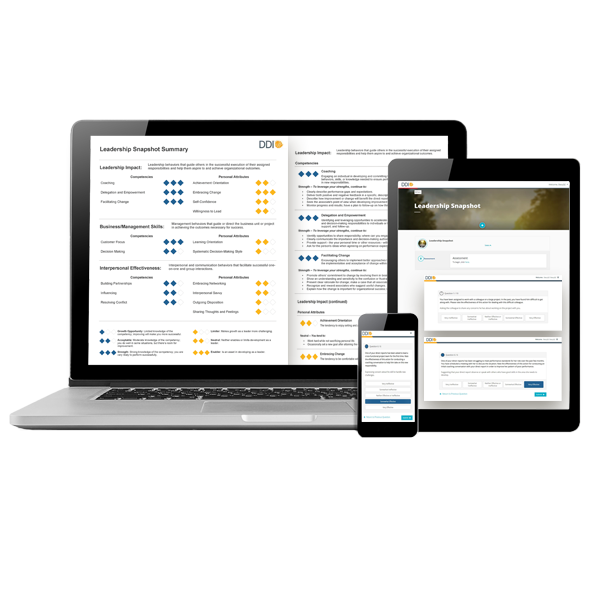Leadership Test
Fast Data to Develop and Select First-Level Leaders
Development and selection decisions for first-level leaders often lack data. Most of the time, those decisions are based on a gut feeling that someone will be a natural leader, especially if they’ve been a top performer. But that’s not always the case. A leadership test can quickly give you the objective data you need.
The DDI Leadership SnapshotSM system can quickly identify development needs and predict leadership performance. Our testing services give you a snapshot view to create development plans or make hiring decisions.
And best of all? This leadership test is easy to scale.
80%
of leaders don't have access to high-quality assessments today.
DDI Global Leadership Forecast 2025Measure Personality and Leadership Judgment
Leadership Snapshot gives you data on two angles essential for high-performing leaders at the frontline: personality and leadership judgment. You see personal attributes and tendencies that enable your first-level leaders to grow and succeed. And you also learn their judgment on leadership competencies or behavioral skills needed on the job.
Leadership Snapshot measures 18 factors across three categories: Leadership Impact, Business and Management Skills, and Interpersonal Effectiveness. As a result, this leadership test gives you a well-rounded picture of a candidate’s likely capability and motivation to lead.

Accelerate Top Performers
Leadership Snapshot can give current first-level leaders a new lens to better understand their strengths and gaps. With the leadership test results, you can also create targeted development plans and help individuals prepare for a leadership position.
Leadership Snapshot participants get a feedback report with their results and an in-depth description of competencies and personality traits. They also get actionable tips to guide their development. Plus, you get aggregate reports with trends to inform group development.
7.8x
Top performers on DDI’s leadership test were 7.8 times more likely to excel in leadership management.
DDI Impact Research ResultsIncrease Confidence in Selection Decisions
Candidates with higher leadership test scores are more likely to succeed in a leadership role. You can use this data to help you make better decisions about candidates for first-level leader roles.
When using the leadership test for selection, we recommend pairing it with a behavioral interview. Hiring managers can review the test results in advance and receive a set of behavioral interview questions for follow-up. That way, they can explore how candidates’ scores relate to their behavior on the job.
When Leadership Snapshot is used with DDI’s behavioral interviewing system, you can get a more complete picture of your candidates.
Need to Assess Leadership Skills?
Leadership Snapshot provides data for a moment in time on personality and judgment. It’s also a great data point for hiring or promotion. But it’s not going to assess actual strengths and gaps in leadership skills.
Looking for a tool to measure behavioral skills and frontline leader readiness? DDI’s Manager Ready® provides an engaging day-in- the-life experience for your leaders, also giving you deep insight into each leader’s strengths and weaknesses.
Check out the Ultimate Guide to Leadership Assessment
recommended Resources
-
On-demand Webinar: Explore the different types of assessments and how and when to use them.
WEBINARCreate a Data-Driven Leadership Strategy: Everything You Need to Know About Assessments
60 min
-
It's a question we get all the time: "Why do a leadership assessment?" Think of it this way: Most companies don't make expensive choices without data. So why would you do it with your leadership?
BLOGWhy Do a Leadership Assessment?
9 min
-
On-demand Webinar: Learn how to get fast and objective data to help you select on develop frontline leaders with DDI’s Leadership Snapshot test.
WEBINARTake a Leadership Snapshot: Fast Data to Select or Develop First-Line Leaders
60 min